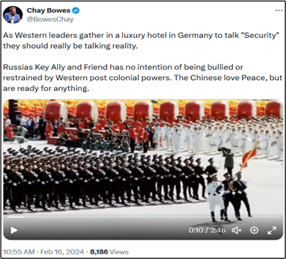Hot spots and topics worldwide, China
The US expanding military footprint on China’s doorsteps
Military balance of great powers can be considered also geo-strategically, where locations of adversary’s military bases in relation to each great power tell the overall military pressure targeted each player respectively. The basic setup has been clear for years, as seen in this picture below.
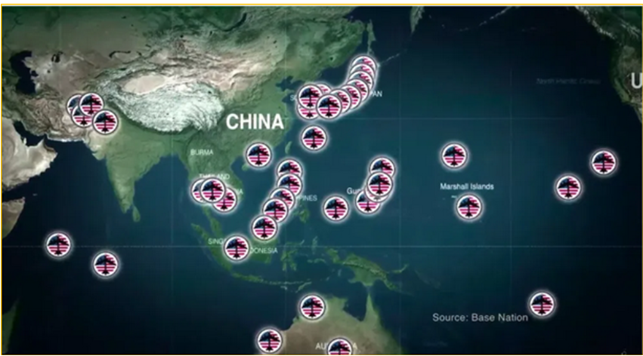
A series of recent announcements by the US reflect its large and still growing military presence across Asia-Pacific, particularly in East and Southeast Asia. Together, they reflect a continued and increasing desire by Washington to encircle and contain China.
These announcements include plans for expanding the number of US air bases across the region as part of the US Air Force’s (USAF) new “Agile Combat Employment” (ACE) doctrine. It also includes plans for a “civilian port” in the Batanes islands, less than 200 km from the Chinese island province of Taiwan. Then, recently announced plans by the US Department of Defense to create drone swarms for countering China’s growing advantage in materiel and manpower.
A recent article published by Defense One titled, “Air Force expanding number of bases in Pacific over next decade,” reported on the Pentagon’s plans to expand the number of air bases across the Pacific over the next decade to fulfill the requirements of the USAF’s Agile Combat Employment (ACE) doctrine. More than simply increasing the number of air bases in the region, ACE seeks to disperse U.S. aircraft, ammunition, and personnel among a larger number of smaller bases, thus creating more targets for potential adversaries and increasing the overall survivability for USAF assets.
Reuters, in an article titled, “Exclusive: U.S. military in talks to develop port in Philippines facing Taiwan,” would report: The US military is in talks to develop a civilian port in the remote northernmost islands of the Philippines, the local governor and two other officials told Reuters, a move that would boost American access to strategically located islands facing Taiwan. The US military involvement in the proposed port in the Batanes islands, less than 200 km (125 miles) from Taiwan, could stoke tensions at a time of growing friction with China and a drive by Washington to intensify its longstanding defense treaty engagement with the Philippines.
Defense One, in another article titled, “‘Hellscape’: DOD launches massive drone swarm program to counter China,” would report: China’s most important asset in potential war with the United States is “mass,” says Deputy Defense Secretary Kathleen Hicks. China has more ships, more missiles and more people.” To counter that advantage, the Defense Department will launch an initiative called Replicator to create cheap drones across the air, sea, and land in the “multiple thousands” within the next two years. Cheap drones, of the type Ukraine has deployed to great effect against Russia, can be produced close to the battlefield at much lower cost than typical Defense Department weapons.
The proliferation of swarms of cheap drones being used by both sides in Ukraine are made possible by easy-to-purchase Chinese-made components. The whole reason China has “more ships” and “more missiles” than the United States in the first place is because of its much larger industrial base. Whatever drone swarm the US may be preparing for China, China will have the capacity to create more and much larger “swarms” to strike back.
Top level appointments, China-Russia relations
US-China meetings fail to produce breakthrough on Red Sea shipping attacks
Lack of progress in addressing two key international crisis points (Ukraine, Middle East) underscores the limitations in the Biden administration’s diplomatic outreach to Beijing.
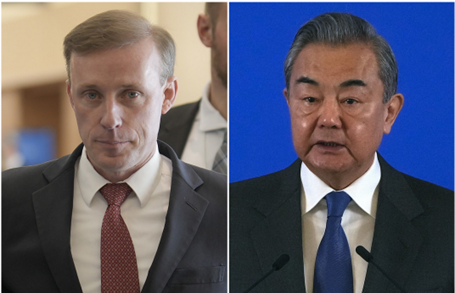
US National Security Adviser Jake Sullivan, left and Chinese Foreign Minister Wang Yi
US National security adviser Jake Sullivan raised concerns about the ongoing attacks in the meetings with China’s Foreign Minister Wang Yi in Bangkok, Thailand, on January 26-27. But the talks ended with no sign that China is willing to take decisive steps to use its economic influence on Iran, which funds and equips Yemen’s Houthi militia to stem the threat to global supply chains. In other words, the US failed in two days of talks to prod China into pressuring Iran to stop Houthi attacks on commercial shipping in the Red Sea.
Those attacks, which began two months ago, have prompted multiple US and British air strikes on Houthi positions in Yemen in recent weeks. The Biden administration is also hitting a brick wall in trying to prod Beijing to convince close ally North Korea to scale back its nuclear weapons program, curtail support for Russia’s war on Ukraine and ease up on its increasingly hostile rhetoric toward South Korea. Sullivan and Wang “discussed the ongoing crisis and hope to have follow up discussions at lower levels in the coming weeks and months,” the official release said.
After the surprise January 26-27 meeting between US National Security Advisor Jake Sullivan and Chinese Foreign Minister Wang Yi, Taiwan independence remains the most problematic issue in US-China relations. The Taiwan problem will remain, especially since the independence-supporting Democratic Progressive Party (DPP) held Taiwan’s presidency following the island’s recent election.
Critically, to assure Beijing and maintain the hope of a diplomatic resolution to the Taiwan question, Washington should more publicly assure Beijing that it would accept the peaceful reunification of China and Taiwan.
To his credit, US President Joe Biden indicated this to Chinese leader Xi Jinping during their November 2023 meeting in San Francisco. Not only should Biden and his successors restate this publicly but US government agencies should also make this an official talking point for both bilateral and multilateral engagements. Moreover, Washington should reverse its trend of official visits with Taiwan, which has worsened Taiwan’s security for the sake of symbolism.
Xi Jinping had a telephone conversation with Putin, February 8, 2024.

Russian President Vladimir Putin and Chinese President Xi Jinping summed up the development of comprehensive partnership and strategic cooperation between the two countries over the recent period in a telephone conversation. It was stated again during the conversation that friendly ties between Moscow and China “are at an unprecedentedly high level,” the statement said. Moreover, the sides “stressed with satisfaction that bilateral trade turnover reached the record level of $227.7 billion,” the press service noted.
China and Russia will jointly promote “inclusive economic globalization and contribute to developing the global governance system in a fairer and more reasonable direction.” Both parties are ready to boost multipolarity and international multilateral cooperation. “China actively supports Russia’s work as the BRICS chair in 2024 and is ready to deepen international multilateral cooperation with Russia” Xi was saying.
This year 2024 marks the 75th anniversary of diplomatic relations between China and Russia. The two leaders earlier announced holding events as part of the Year of Sino-Russian Culture in 2024-2025.
China’s stance on US biolabs in Ukraine
Russia and China held consultations concerning US military biological activities on February 1. The US continues to refuse to answer to crucial questions.
The Chinese diplomat stressed that these questions, which are largely consonant with those posed by Moscow, were not followed by any proper response from either the United States or Ukraine.
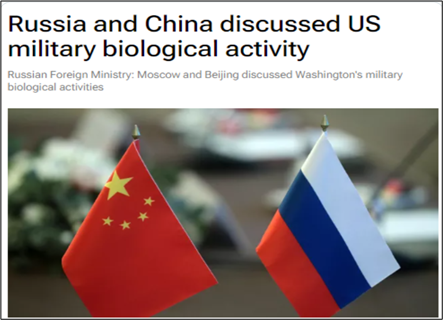
Victoria Nuland effectively confirmed the presences of US biolabs in Ukraine – biolabs with apparently extremely dangerous pathogens. “In September 2022, at a consultative meeting of the BTWC, Beijing raised, with Washington and Kiev, a number of questions about the work of biological laboratories on the territory Ukraine.

Taiwan after election
William Lai Ching-te, the candidate of Taiwan’s ruling party, the Democratic Progressive Party (DPP), won Taiwan’s presidential elections held in January 2024 and China described it as “a choice between war and peace”. Under the constitution, former Taiwanese President “Tsai Ing-wen” is not eligible to run again after two terms in office. This result advocates Taiwan’s independent identity and rejects China’s claims to sovereignty over it, assumes power to DPP for the third consecutive term, which is unprecedented in Taiwan’s electoral system. Voters in Taiwan chose William Lai Ching-te as their president in a historic election, cementing an increasingly divergent path from China.
The move angered Beijing, which issued a statement shortly after the results came out, insisting that “Taiwan is part of China”. Although Beijing called for “peaceful reunification”, it also did not rule out the use of force, portraying Taiwan’s elections as a choice between “war and peace”. This may explain the significance of China strengthening its military presence around the Taiwanese island in recent months before the start of the Taiwanese presidential elections, which has increased fears of a possible conflict.
Taiwan announced shortly before the Taiwanese presidential elections that it had detected activity of Chinese aircraft and warships near the Taiwanese island. The reasons for these Chinese military movements in the Taiwan Strait are to prevent collusion between Taiwanese separatists who are affiliated with and loyal to the United States and those who support the principle of Taiwan’s separation from the motherland in Beijing. All of these Chinese military movements aim to protect the integrity of Chinese territory. The Beijing government described Lai as a “dangerous separatist” and rejected his repeated calls to hold talks with it.
On the other hand, the United States, Taiwan’s largest ally, was quick to congratulate Lai on his victory, and Secretary of State “Anthony Blinken” praised the “strong democratic system and electoral process” on the Taiwanese island. “Anthony Blinken” confirmed in a statement that Washington is “committed to maintaining peace and stability across the Strait”.
Taiwanese voters also chose their legislature, and the Democratic Progressive Party lost its majority as the opposition gained more votes and support, although no party gained enough seats to control parliament. The presence of an opposition-dominated legislature in Taiwan, with a president from the Democratic Progressive Party, may mean that the process of governing Taiwan will become more difficult.
China’s stance is clear, national reunification inevitable
After DPP candidate Lai Ching-te and his running mate Hsiao Bi-khim won the leadership election in Taiwan recently, some foreign media began claiming the risk of military conflicts across the Taiwan Strait has increased.
China wants to realize the reunification of the Taiwan island with the motherland through peaceful means, by following the “one country, two systems” principle. But “Taiwan independence” forces on the island have been opposing this with the help of some countries and by “internationalizing the Taiwan question”. This has compelled Beijing to reiterate its position that it does not “renounce the use of force” to achieve the goal of national reunification.
The Chinese mainland has been making increasing efforts to settle the Taiwan question. Claiming Beijing has proposed to realize national reunification before the 100th year of the founding of the People’s Liberation Army in 2027, the Taiwan authorities have alleged that the mainland would seek reunification using military force only in 2027. So, they sought more help from the United States to prevent the inevitability of national reunification.
On its part, the US has been playing the “Taiwan card” and stirring up trouble across the Taiwan Strait. It has also been spreading speculations that Beijing seeks to reunify the Taiwan island with the motherland through force before 2027.
Washington has been hyping up the Taiwan question and getting increasingly involved in cross-Strait affairs, in order to prevent not only the Chinese nation’s reunification but also to distract the American people’s attention from burning domestic issues such as a slowing US economy and the widening income gap. What the US has said and done have greatly affected the judgment of the Taiwan authorities on how the mainland would deal with the Taiwan question.
China is particularly angry about the “dirty tricks” of the US in the “balance of military power game” across the Strait by increasing its arms sales to the island. The Joe Biden administration has announced 12 rounds of arms sales to Taiwan, including five in 2023. Although Washington knows that Taiwan, even with US military supplies, cannot change the cross-Strait strategic balance, it continues to sell weapons and military equipment to the island.
From China’s point of view, the biggest obstacle to resolving the Taiwan question is the interference of the US. As long as the US adheres to the one-China principle, does not play the “Taiwan card”, and stops selling arms to Taiwan and sending the wrong signal to the Taiwan authorities, the Taiwan question can be resolved through peaceful means.
The white paper titled “Taiwan Question and China’s Reunification in the New Era“, issued by the Taiwan Affairs Office of the State Council and the State Council Information Office in 2022 said, “the basic policy of upholding One-Country, Two-Systems”, is to never separate any part of Chinese territory from China”. The white paper also said, “China is firmly committed to peaceful development”, and highlighted a series of measures to improve cross-Strait relations and realize peaceful national reunification.
Recent incidents and military situation & positioning analysis
Chinese overall military-strategic analysis: The US has lost the war in Ukraine. The US is losing the war in the Middle East. (Attacking Iran would be catastrophic). The US will lose in South China Sea. Delusional people in Washington DC are in a dead end.
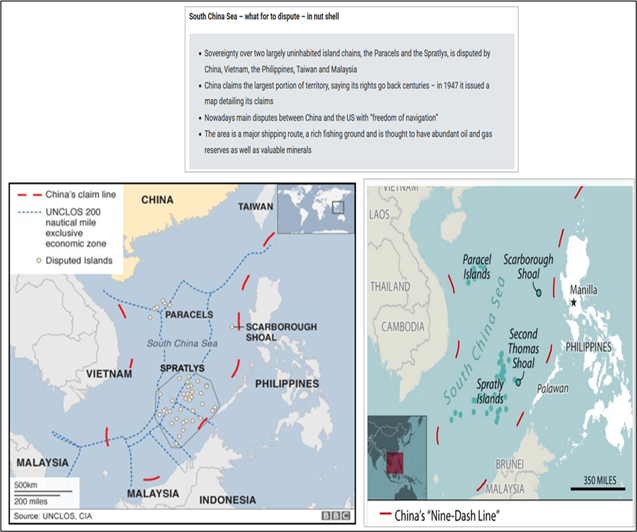
China – the Philippines dispute on islands and reefs
January 25, 2024, China resolutely opposes the Philippine side conducting any form of construction on China’s islands and reefs illegally occupied by them, said a Chinese defense spokesperson at a regular press conference. Chief of Staff of the Philippine Armed Forces said that the Philippines is planning to develop the South China Sea islands and reefs and acquire more ships and radars. Some analysts say that the Philippine side is intended to build outposts in the South China Sea.
Chinese Defense Forces Colonel Wu Qian said that China has indisputable sovereignty over Nansha Qundao and its adjacent waters, which is fully backed by historical and jurisprudential basis. China resolutely opposes the Philippine side conducting any form of construction on China’s islands and reefs illegally occupied by them. Colonel Wu stressed that China is willing to work together with the Philippines to resolve differences through bilateral dialogues and consultation. However, if the Philippine side insists on taking its own course, China will surely take firm countermeasures.
In mid-February, the China coast guard expelled a Philippine vessel that entered waters off Huangyan Island in the South China Sea. In a statement, Gan Yu, a spokesperson for the China coast guard, reported that a vessel from the Philippine Bureau of Fisheries and Aquatic Resources had illegally intruded into the adjacent waters of China’s Huangyan Island. He stressed that China holds indisputable sovereignty over Huangyan Island and its adjacent waters.
Deployment of US Special Forces on Kinmen and Matsu
February 8, the US just decided to place US Army Special Forces “on a long-term basis” on Kinmen and Matsu islands, literally a few hundred feet away from the Chinese mainland, which is unbelievably provocative. At the same time the US is “cautioning China against changing the status quo on Taiwan, which is vital to maintaining peace”.
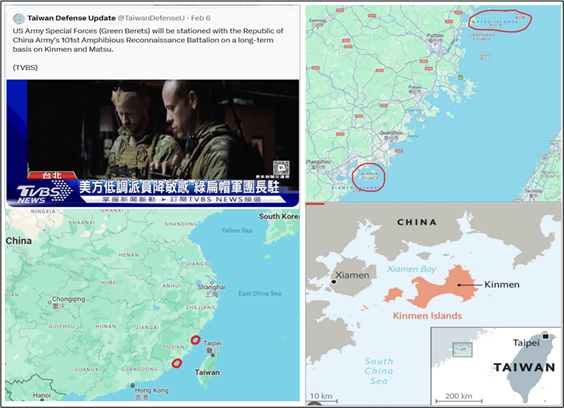
China sees this as a major US provocation towards China. US special forces will be stationed on Kinmen Island, which is only 2 kilometers away from mainland China!
Indo-Pacific military activity
Taiwan’s defense ministry announced on January 27 that over 30 Chinese warplanes were headed toward its country, in addition to navy ships. Six Chinese navy vessels were also headed to Taiwan, and 13 of China’s warplanes crossed the median of the Taiwan Strait. According to the Associated Press, Taiwanese officials are currently monitoring the situation. China sends several warplanes, navy ships toward Taiwan shortly after US-China talks. Two days before, the Chinese government called out the US Navy for sailing a warship through the Taiwan Strait, accusing the US of causing “trouble and provocation on China’s doorstep.”
Despite wide-range military activity in Indo-Pacific, it’s unlikely that China is ready to “demonstrate force against Taiwan” at any point in the near- or mid-term future … unless the US deliberately provokes them.
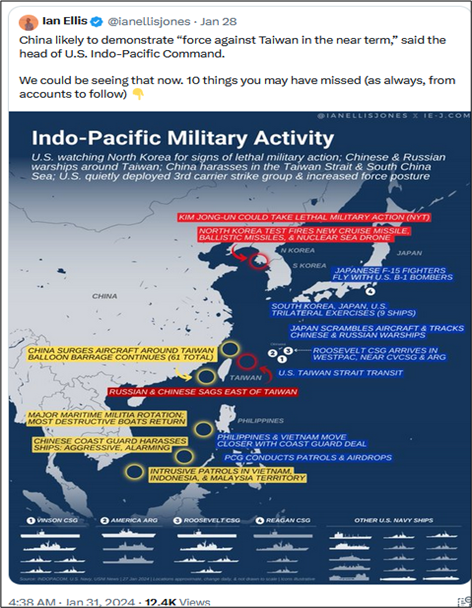
US will deploy half of its aircraft carriers in the Pacific to contain China There are currently three American aircraft carriers in the western Pacific Ocean and two more are planned to arrive there in the near future, WION reports. Their arrival will mark the first time that 5 of the 11 powerful American aircraft carrier contingents will be deployed in the region.
According to military analysts, this will be done to counter the growing military activity of China and North Korea, as rising tensions in the South China Sea are a major concern for Washington. In addition, such measures are intended to demonstrate to allies the support and readiness of the United States to solve multiple strategic problems simultaneously.

From China’s point of view, the conflicts in Ukraine and the Middle East have not distracted Washington from flexing its military muscles in the Asia-Pacific. Through one drill after another, the US is coercing regional countries into taking its side, further intensifying regional conflicts and transforming the Asia-Pacific into a more dangerous place.
In mid-February, the US, Australian and Japanese warships conducted a trilateral joint operation in the South China Sea to “promote transparency, rule of law, freedom of navigation and all principles that underscore security and prosperity in the Indo-Pacific.”
Chinese experts said that these military drills, as an important part of the substantial implementation of the US’ Indo-Pacific Strategy, intend to strengthen military cooperation between the US and its Asia-Pacific allies, but the real drive is to prepare for a possible clash against Beijing, Washington’s imagined military enemy.
The US is taking greater steps to pave the way for its envisioned security layout in the Asia-Pacific region, as it is now determined to contain China through its Indo-Pacific Strategy, holding other countries hostage for its own selfish interests and to safeguard its global hegemony.
Foreign Affairs published an article “The Taiwan Catastrophe” from American point of view and the critic can be encapsulated in the attached text of Thomas Hon Wing Polin.
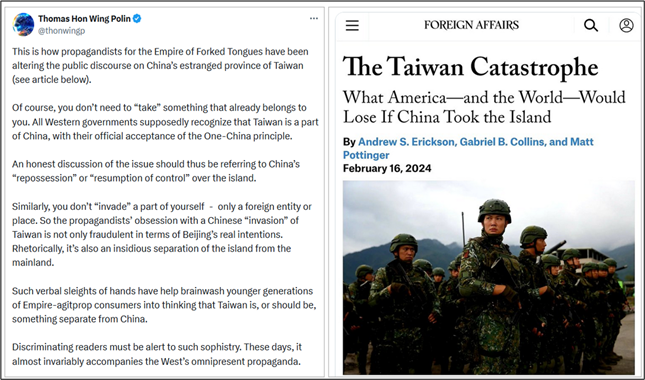
What America—and the World—Would Lose If China Took the Island
By Andrew S. Erickson, Gabriel B. Collins, and Matt Pottinger
February 16, 2024
Stoltenberg’s warmongering
Jens Stoltenberg, secretary-general of NATO, is visiting the US from January 27 to February 1. During his stay in the US, the NATO chief repeatedly mentioned the allied support to Ukraine against Russia while meeting with Secretary of Defense Lloyd Austin and US Secretary of State Antony Blinken, according to releases from NATO.
Stoltenberg is attempting to link Ukraine with the Taiwan question to upgrade the narrative of the “China threat” to persuade the US to maintain support for Ukraine, which Chinese analysts criticized as fanning confrontations globally and will not help overcome Western fatigue over support for Kiev.
While addressing supporting Ukraine is “an investment” in the West’s own security and “serves US interests,” Stoltenberg mentioned China on multiple occasions. In his meeting with Austin and in an interview with Fox News, Stoltenberg claimed that China is closely watching how long the US and Europe can maintain support for Ukraine. “Today it’s Ukraine, tomorrow it may be Taiwan,” he said.
No matter how hard the NATO chief emphasizes the threats posed by China and Russia, it is challenging to alleviate the weariness of the US and the West in supporting Ukraine, analysts said.
They noted that as the Russia-Ukraine conflict approaches its second anniversary, NATO’s persistent tactics of exacerbating tensions and instigating conflicts worldwide only serve to destabilize the region.
Conclusions – A future war with China
The war is still unlikely between China and Taiwan, despite the visit of former US House Speaker “Nancy Pelosi” to Taiwan in August 2022, which escalated tensions to a new level. But even if a Sino-Taiwan war is unlikely, it is not impossible, as the Russian invasion of Ukraine strongly reflects. There are also serious attempts by the ruling Democratic Progressive Party in Taiwan to prepare for war, by trying to strengthen Taiwan’s relations with the United States of America and other like-minded democracies that support Taiwan’s secession from the motherland on mainland China, including strengthening its relations with non-allies. The Beijing government described voting for Taiwan’s Democratic Progressive Party, which supports Taiwan’s secession from China, in the presidential elections as a vote for war.
Amid the current conflict in Ukraine, Ukrainian drones have repeatedly targeted Russian air bases deep within Russian territory. Despite the vast majority of these drones being disabled or intercepted, small numbers still occasionally make it through, causing damage. Had Ukraine possessed greater long-range strike capabilities or were Russian air defenses less capable, the damage to these centralized air bases could have been much greater and may have even potentially disrupted Russian combat operations.
The wisdom behind the US Air Force’s “ACE” doctrine, which was presented above, basically is apparent. China is certainly learning from the ongoing conflict in Ukraine and is likely studying the posture of its own air assets in relation to the US military’s build-up and plans to not only disperse their assets over a wider number of smaller facilities, but also their plans to utilize drone swarms in addition to other long-range strike capabilities on a scale much larger than Ukraine is currently using.
Finally, as the US moves closer and closer to Chinese territory with its military and “civilian” infrastructure, and specifically near “choke points” that could potentially restrict or cut off Chinese maritime shipping, Beijing must consider contingencies to sustain its economy including its trade even under the worst-case scenario.
In many ways, the “Belt and Road Initiative” (BRI) already partially accomplishes this. Growing trade with Russia across Russia and China’s shared border represents another means of maintaining essential trade, including the flow of energy and raw materials, even if the US implements a naval blockade in the Indo-Pacific.
Taken together, it is clear the US is moving as quickly as possible to position itself best for a coming conflict with China. While US leaders and the Western media suggest China is rushing to war “by 2025,” it is clear that time is on China’s side and that it is the US rushing to war.
The economic and industrial advantages China enjoys over the US today, did not exist three decades ago. A decade from now, however, China’s advantages over the US industrially and thus militarily will only have grown. The US seeks to exploit a closing window of opportunity to fight now before the odds tilt any further in China’s favor.
But considering the realities of these recent announcements by the US and how little they actually change the odds in Washington’s favor, some may conclude that the window has already shut. Video in Chay Bowes tweet tells a lot of China’s posture.
